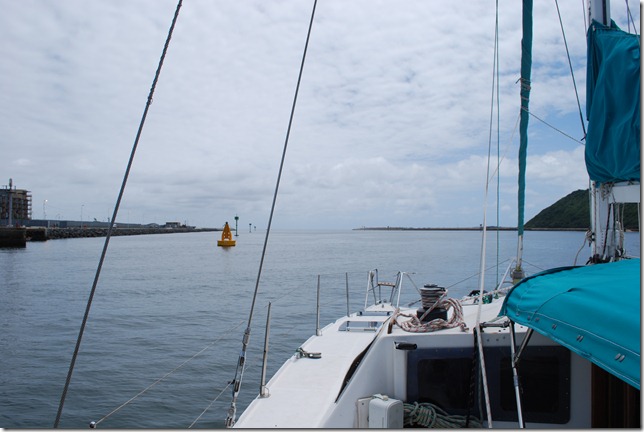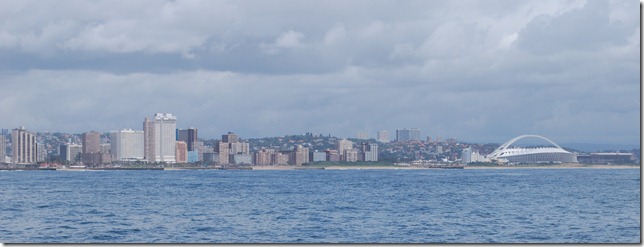Lat: 30 21.848′ S
Lon: 30 56.805′ E
 Heading out the Duran harbor entrance
Heading out the Duran harbor entrance
 A small piece of Durban’s beach skyline and iconic World Cup stadium
A small piece of Durban’s beach skyline and iconic World Cup stadium
So far, the Wild Coast has been anything but, which is just fine with me, except that I could use a little more wind to make it in to East London before the next southwesterly blows in. As it is, I’m motorsailing at about 4.5-5+ knots on a beam reach, but just as I’m sitting down to write this I can feel us speeding up and hear the wind generators starting to spin. It would have been nice to leave early in the morning, but I had to wait until 8 am for the marina office to open so I could clear out and then check out with the port and customs. Check out is a little different than anywhere else we’ve been. All foreign yachts are required to check out anytime they leave a port, even if it’s just for another domestic destination or a daysail. You have to provide a fair amount of boat and radio information, a sketch of your boat’s profile, and next of kin contact information. With an early start, I was still able get all the formalities out of the way as well as enjoy a veg curry pie and a couple of samosas at my last visit to Anver’s corner store. The friendly Indian proprietor and I had a short chat and he wished me luck. I guess I’ve eaten enough bean bunny chows and what not there that they recognize me by now. The other day I was 2 Rand short, and they let me come back later in the afternoon and settle up.
2 Rand isn’t much more than a quarter, but I would guess that sort of thing is still rare in Durban. Virtually all of the shops near the yacht basin either have a security guard of some sort standing near the door or a locked iron gate for a front door that you have to be buzzed in and out of by someone inside the store. That said, we walked around the downtown area quite a bit and even back and forth to the beach a couple of times with no problems whatsoever. For the record, we didn’t hear any firsthand accounts of trouble in downtown Durban while we were there and felt pretty comfortable during the day by the time we left. Downtown Durban may not be the safest city in the world, but it’s Beverly Hills compared to Colon, Panama, and the food prices are definitely a good deal.
The daily rains at random times never stopped, which is apparently unusual for Durban this time of year, but the hot, humid spells in between were evidently more typical. Either Wednesday or Thursday was a holiday here and it generally marks the beginning of a 2 week period when many of South Africa’s businesses close their doors and everyone goes on holiday. Clyde at Texwise, who’s been great to work with, was scrambling to get us the last of our stuff. We’d originally asked him just to patch the jib, but he had reasonable prices and there were a number of things that needed to be done before we sold the boat, so he ended up repairing the bimini and providing new trampolines, a mainsail cover and suncovers as well. He was the only guy that responded to my email about a jib repair that I sent to several local businesses, and it ended up working out for him. In spite of the rain, with the holiday season in full swing, the docks have been full of holiday sailors and groups of people taking yacht certification courses. In South Africa, you’re required to have a skipper’s ticket to go sailing, so there’s a thriving certification business and the yachts motoring by loaded down with newbies made me smile. They probably look a lot like we did a few years back on one of the great charter trips from Florida to the Bahamas that Wes used to organize. Like we were back then, they’re a far cry from the tanned, thin, and not so fashionably dressed small crews that we’ve become accustomed to sailing the oceans with.
I guess the thin part may be a bit of an overstatement for me these days, though. I needed to go up the stick to finish off the rigging adjustments and repairs before leaving, which is usually a two-person job. But, I’d seen riggers and Martin do it with a block and tackle setup, so I found the line and blocks I needed for a 4:1 setup at the marine stores across the street and gave it a shot. My setup worked out a little awkward in that one hand has to pull down while the other pulls up, and doing that with a 4:1 purchase up a 50 foot mast is the equivalent of pulling a quarter of your weight plus friction 200 feet while you’re sitting in a bosun’s chair. Needless to say, I had numerous breaks to stop and ponder why Lauren had become such a good cook, why I’d been eating 4 meals a day at sea, why I haven’t been working out at sea, and why we’d gone without crew, leaving me to look after all the leftovers. I eventually made it up, but I’m still thinking about how I can convert the setup into a 5:1 purchase.
In typical fashion, I’ve so far managed to find a counter current instead of the strong, helpful current that’s supposed to be out here. The good news is that as long as I can spend all the good weather windows between now and then at sea, the forecast is looking good for making or nearly making it to Cape Town by New Years, which has been something we’ve been looking forward to for a long time and should see us meeting up with a number of friends.
It’s hard to believe, but this is the first time I’ve ever singlehanded a sailboat, ever. I somehow never even made a daysail by myself, so it’s a new experience. It’s novel to me, even after sailing 20,000 miles, so I may talk a little bit about that next time.

